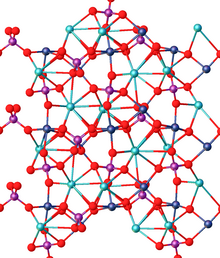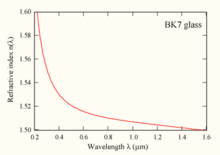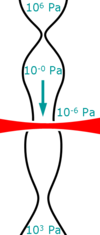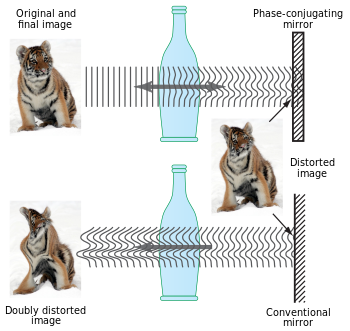Structure of KTP crystal, viewed down b axis, used in second harmonic generation.
Nonlinear optics (NLO) is the branch of optics that describes the behavior of light in nonlinear media, that is, media in which the dielectric polarization P responds nonlinearly to the electric field E of the light. The nonlinearity is typically observed only at very high light intensities (values of atomic electric fields, typically 108 V/m) such as those provided by lasers. Above the Schwinger limit, the vacuum itself is expected to become nonlinear. In nonlinear optics, the superposition principle no longer holds.
Nonlinear optics remained unexplored until the discovery in 1961 of second-harmonic generation by Peter Franken et al. at University of Michigan, shortly after the construction of the first laser by Theodore Harold Maiman. However, some nonlinear effects were discovered before the development of the laser. The theoretical basis for many nonlinear processes were first described in Bloembergen's monograph "Nonlinear Optics".
Nonlinear optical processes
Nonlinear optics explains nonlinear response of properties such as frequency, polarization, phase or path of incident light. These nonlinear interactions give rise to a host of optical phenomena:Frequency-mixing processes
- Second-harmonic generation (SHG), or frequency doubling, generation of light with a doubled frequency (half the wavelength), two photons are destroyed, creating a single photon at two times the frequency.
- Third-harmonic generation (THG), generation of light with a tripled frequency (one-third the wavelength), three photons are destroyed, creating a single photon at three times the frequency.
- High-harmonic generation (HHG), generation of light with frequencies much greater than the original (typically 100 to 1000 times greater).
- Sum-frequency generation (SFG), generation of light with a frequency that is the sum of two other frequencies (SHG is a special case of this).
- Difference-frequency generation (DFG), generation of light with a frequency that is the difference between two other frequencies.
- Optical parametric amplification (OPA), amplification of a signal input in the presence of a higher-frequency pump wave, at the same time generating an idler wave (can be considered as DFG).
- Optical parametric oscillation (OPO), generation of a signal and idler wave using a parametric amplifier in a resonator (with no signal input).
- Optical parametric generation (OPG), like parametric oscillation but without a resonator, using a very high gain instead.
- Spontaneous parametric down-conversion (SPDC), the amplification of the vacuum fluctuations in the low-gain regime.
- Optical rectification (OR), generation of quasi-static electric fields.
- Nonlinear light-matter interaction with free electrons and plasmas.
Other nonlinear processes
- Optical Kerr effect, intensity-dependent refractive index (a
effect).
- Self-focusing, an effect due to the optical Kerr effect (and possibly higher-order nonlinearities) caused by the spatial variation in the intensity creating a spatial variation in the refractive index.
- Kerr-lens modelocking (KLM), the use of self-focusing as a mechanism to mode-lock laser.
- Self-phase modulation (SPM), an effect due to the optical Kerr effect (and possibly higher-order nonlinearities) caused by the temporal variation in the intensity creating a temporal variation in the refractive index.
- Optical solitons, an equilibrium solution for either an optical pulse (temporal soliton) or spatial mode (spatial soliton) that does not change during propagation due to a balance between dispersion and the Kerr effect (e.g. self-phase modulation for temporal and self-focusing for spatial solitons).
- Cross-phase modulation (XPM), where one wavelength of light can affect the phase of another wavelength of light through the optical Kerr effect.
- Four-wave mixing (FWM), can also arise from other nonlinearities.
- Cross-polarized wave generation (XPW), a
effect in which a wave with polarization vector perpendicular to the input one is generated.
- Modulational instability.
- Raman amplification
- Optical phase conjugation.
- Stimulated Brillouin scattering, interaction of photons with acoustic phonons
- Multi-photon absorption, simultaneous absorption of two or more photons, transferring the energy to a single electron.
- Multiple photoionisation, near-simultaneous removal of many bound electrons by one photon.
- Chaos in optical systems.
Related processes
In these processes, the medium has a linear response to the light, but the properties of the medium are affected by other causes:- Pockels effect, the refractive index is affected by a static electric field; used in electro-optic modulators.
- Acousto-optics, the refractive index is affected by acoustic waves (ultrasound); used in acousto-optic modulators.
- Raman scattering, interaction of photons with optical phonons.
Parametric processes
Nonlinear effects fall into two qualitatively different categories, parametric and non-parametric effects. A parametric non-linearity is an interaction in which the quantum state of the nonlinear material is not changed by the interaction with the optical field. As a consequence of this, the process is "instantaneous". Energy and momentum are conserved in the optical field, making phase matching important and polarization-dependent.Theory
Parametric and "instantaneous" (i.e. material must be lossless and dispersionless through the Kramers–Kronig relations) nonlinear optical phenomena, in which the optical fields are not too large, can be described by a Taylor series expansion of the dielectric polarization density (dipole moment per unit volume) P(t) at time t in terms of the electrical field E(t):Wave equation in a nonlinear material
Central to the study of electromagnetic waves is the wave equation. Starting with Maxwell's equations in an isotropic space, containing no free charge, it can be shown thatNote that one can normally use the vector identity
 ),
),
Nonlinearities as a wave-mixing process
The nonlinear wave equation is an inhomogeneous differential equation. The general solution comes from the study of ordinary differential equations and can be obtained by the use of a Green's function. Physically one gets the normal electromagnetic wave solutions to the homogeneous part of the wave equation:In general, an n-th order nonlinearity will lead to (n + 1)-wave mixing. As an example, if we consider only a second-order nonlinearity (three-wave mixing), then the polarization P takes the form
Note: Parametric generation and amplification is a variation of difference-frequency generation, where the lower frequency of one of the two generating fields is much weaker (parametric amplification) or completely absent (parametric generation). In the latter case, the fundamental quantum-mechanical uncertainty in the electric field initiates the process.
Phase matching
Most transparent materials, like the BK7 glass shown here, have normal dispersion: the index of refraction decreases monotonically
as a function of wavelength (or increases as a function of frequency).
This makes phase matching impossible in most frequency-mixing processes.
For example, in SHG, there is no simultaneous solution to  and
and  in these materials. Birefringent materials avoid this problem by having two indices of refraction at once.
in these materials. Birefringent materials avoid this problem by having two indices of refraction at once.
 and
and  in these materials. Birefringent materials avoid this problem by having two indices of refraction at once.
in these materials. Birefringent materials avoid this problem by having two indices of refraction at once. , with the wave vector
, with the wave vector  , where
, where  is the velocity of light in vacuum, and
is the velocity of light in vacuum, and  is the index of refraction of the medium at angular frequency
is the index of refraction of the medium at angular frequency  . Thus, the second-order polarization at angular frequency
. Thus, the second-order polarization at angular frequency  is
is
 within the nonlinear medium, the oscillating second-order polarization radiates at angular frequency
within the nonlinear medium, the oscillating second-order polarization radiates at angular frequency  and a corresponding wave vector
and a corresponding wave vector  . Constructive interference, and therefore a high-intensity
. Constructive interference, and therefore a high-intensity  field, will occur only if
field, will occur only if
| Polarizations | Scheme | ||
|---|---|---|---|
| Pump | Signal | Idler | |
| e | o | o | Type I |
| e | o | e | Type II (or IIA) |
| e | e | o | Type III (or IIB) |
| e | e | e | Type IV |
| o | o | o | Type V (or type 0, or "zero") |
| o | o | e | Type VI (or IIB or IIIA) |
| o | e | o | Type VII (or IIA or IIIB) |
| o | e | e | Type VIII (or I) |
Most common nonlinear crystals are negative uniaxial, which means that the e axis has a smaller refractive index than the o axes. In those crystals, type-I and -II phase matching are usually the most suitable schemes. In positive uniaxial crystals, types VII and VIII are more suitable. Types II and III are essentially equivalent, except that the names of signal and idler are swapped when the signal has a longer wavelength than the idler. For this reason, they are sometimes called IIA and IIB. The type numbers V–VIII are less common than I and II and variants.
One undesirable effect of angle tuning is that the optical frequencies involved do not propagate collinearly with each other. This is due to the fact that the extraordinary wave propagating through a birefringent crystal possesses a Poynting vector that is not parallel to the propagation vector. This would lead to beam walk-off, which limits the nonlinear optical conversion efficiency. Two other methods of phase matching avoid beam walk-off by forcing all frequencies to propagate at a 90° with respect to the optical axis of the crystal. These methods are called temperature tuning and quasi-phase-matching.
Temperature tuning is used when the pump (laser) frequency polarization is orthogonal to the signal and idler frequency polarization. The birefringence in some crystals, in particular lithium niobate is highly temperature-dependent. The crystal temperature is controlled to achieve phase-matching conditions.
The other method is quasi-phase-matching. In this method the frequencies involved are not constantly locked in phase with each other, instead the crystal axis is flipped at a regular interval Λ, typically 15 micrometres in length. Hence, these crystals are called periodically poled. This results in the polarization response of the crystal to be shifted back in phase with the pump beam by reversing the nonlinear susceptibility. This allows net positive energy flow from the pump into the signal and idler frequencies. In this case, the crystal itself provides the additional wavevector k = 2π/Λ (and hence momentum) to satisfy the phase-matching condition. Quasi-phase-matching can be expanded to chirped gratings to get more bandwidth and to shape an SHG pulse like it is done in a dazzler. SHG of a pump and self-phase modulation (emulated by second-order processes) of the signal and an optical parametric amplifier can be integrated monolithically.
Higher-order frequency mixing
The above holds for
 processes. It can be extended for processes where
processes. It can be extended for processes where  is nonzero, something that is generally true in any medium without any
symmetry restrictions; in particular resonantly enhanced sum or
difference frequency mixing in gasses is frequently used for extreme or "vacuum" Ultra Violet light generation.
In common scenarios, such as mixing in dilute gases, the non-linearity
is weak and so the light beams are focused which, unlike the plane wave
approximation used above, introduces a pi phase shift on each light
beam, complicating the phase matching requirements. Conveniently, difference frequency mixing with
is nonzero, something that is generally true in any medium without any
symmetry restrictions; in particular resonantly enhanced sum or
difference frequency mixing in gasses is frequently used for extreme or "vacuum" Ultra Violet light generation.
In common scenarios, such as mixing in dilute gases, the non-linearity
is weak and so the light beams are focused which, unlike the plane wave
approximation used above, introduces a pi phase shift on each light
beam, complicating the phase matching requirements. Conveniently, difference frequency mixing with  cancels this focal phase shift and often has a nearly self-canceling
overall phase matching condition, which relatively simplifies broad
wavelength tuning compared to sum frequency generation. In
cancels this focal phase shift and often has a nearly self-canceling
overall phase matching condition, which relatively simplifies broad
wavelength tuning compared to sum frequency generation. In  all four frequencies are mixing simultaneously, as opposed to sequential mixing via two
all four frequencies are mixing simultaneously, as opposed to sequential mixing via two  processes.
processes.The Kerr effect can be described as a
 as well. At high peak powers the Kerr effect can cause filamentation of light in air, in which the light travels without dispersion or divergence in a self-generated waveguide. At even high intensities the Taylor series,
which led the domination of the lower orders, does not converge anymore
and instead a time based model is used. When a noble gas atom is hit by
an intense laser pulse, which has an electric field strength comparable
to the Coulomb field of the atom, the outermost electron may be ionized
from the atom. Once freed, the electron can be accelerated by the
electric field of the light, first moving away from the ion, then back
toward it as the field changes direction. The electron may then
recombine with the ion, releasing its energy in the form of a photon.
The light is emitted at every peak of the laser light field which is
intense enough, producing a series of attosecond light flashes. The photon energies generated by this process can extend past the 800th harmonic order up to a few KeV. This is called high-order harmonic generation. The laser must be linearly polarized, so that the electron returns to
the vicinity of the parent ion. High-order harmonic generation has been
observed in noble gas jets, cells, and gas-filled capillary waveguides.
as well. At high peak powers the Kerr effect can cause filamentation of light in air, in which the light travels without dispersion or divergence in a self-generated waveguide. At even high intensities the Taylor series,
which led the domination of the lower orders, does not converge anymore
and instead a time based model is used. When a noble gas atom is hit by
an intense laser pulse, which has an electric field strength comparable
to the Coulomb field of the atom, the outermost electron may be ionized
from the atom. Once freed, the electron can be accelerated by the
electric field of the light, first moving away from the ion, then back
toward it as the field changes direction. The electron may then
recombine with the ion, releasing its energy in the form of a photon.
The light is emitted at every peak of the laser light field which is
intense enough, producing a series of attosecond light flashes. The photon energies generated by this process can extend past the 800th harmonic order up to a few KeV. This is called high-order harmonic generation. The laser must be linearly polarized, so that the electron returns to
the vicinity of the parent ion. High-order harmonic generation has been
observed in noble gas jets, cells, and gas-filled capillary waveguides.
Example uses
Frequency doubling
One of the most commonly used frequency-mixing processes is frequency doubling, or second-harmonic generation. With this technique, the 1064 nm output from Nd:YAG lasers or the 800 nm output from Ti:sapphire lasers can be converted to visible light, with wavelengths of 532 nm (green) or 400 nm (violet) respectively.Practically, frequency doubling is carried out by placing a nonlinear medium in a laser beam. While there are many types of nonlinear media, the most common media are crystals. Commonly used crystals are BBO (β-barium borate), KDP (potassium dihydrogen phosphate), KTP (potassium titanyl phosphate), and lithium niobate. These crystals have the necessary properties of being strongly birefringent (necessary to obtain phase matching, see below), having a specific crystal symmetry, being transparent for both the impinging laser light and the frequency-doubled wavelength, and having high damage thresholds, which makes them resistant against the high-intensity laser light.
Optical phase conjugation
It is possible, using nonlinear optical processes, to exactly reverse the propagation direction and phase variation of a beam of light. The reversed beam is called a conjugate beam, and thus the technique is known as optical phase conjugation (also called time reversal, wavefront reversal and is significantly different from retroreflection).One can interpret this nonlinear optical interaction as being analogous to a real-time holographic process. In this case, the interacting beams simultaneously interact in a nonlinear optical material to form a dynamic hologram (two of the three input beams), or real-time diffraction pattern, in the material. The third incident beam diffracts at this dynamic hologram, and, in the process, reads out the phase-conjugate wave. In effect, all three incident beams interact (essentially) simultaneously to form several real-time holograms, resulting in a set of diffracted output waves that phase up as the "time-reversed" beam. In the language of nonlinear optics, the interacting beams result in a nonlinear polarization within the material, which coherently radiates to form the phase-conjugate wave.
Comparison
of a phase-conjugate mirror with a conventional mirror. With the
phase-conjugate mirror the image is not deformed when passing through an
aberrating element twice.
For the four-wave mixing technique, we can describe four beams (j = 1, 2, 3, 4) with electric fields:
If the pump waves and the signal wave are superimposed in a medium with a non-zero χ(3), this produces a nonlinear polarization field:
As above, the phase-matching condition determines which of these waves is the dominant. By choosing conditions such that ω = ω1 + ω2 − ω3 and k = k1 + k2 − k3, this gives a polarization field:
Further, it can be shown that for a medium with refractive index n and a beam interaction length l, the electric field amplitude of the conjugate beam is approximated by
Note that the constant of proportionality between the signal and conjugate beams can be greater than 1. This is effectively a mirror with a reflection coefficient greater than 100%, producing an amplified reflection. The power for this comes from the two pump beams, which are depleted by the process.
The frequency of the conjugate wave can be different from that of the signal wave. If the pump waves are of frequency ω1 = ω2 = ω, and the signal wave is higher in frequency such that ω3 = ω + Δω, then the conjugate wave is of frequency ω4 = ω − Δω. This is known as frequency flipping.
Angular and linear momenta in optical phase conjugation
Optical phase conjugation in the near field performs the reversal of classical rays, or retroreflection.Classical picture
In classical Maxwell electrodynamics a phase-conjugating mirror performs reversal of the Poynting vector: with respect to incident field:
with respect to incident field:
 in a given moment
in a given moment  for an ideal phase-conjugating mirror.
for an ideal phase-conjugating mirror.
Quantum picture
In quantum electrodynamics the photon with energy also possesses linear momentum
also possesses linear momentum  and angular momentum, whose projection on propagation axis is
and angular momentum, whose projection on propagation axis is  , where
, where
 is topological charge of photon, or winding number,
is topological charge of photon, or winding number,  is propagation axis. The angular momentum projection on propagation axis has discrete values
is propagation axis. The angular momentum projection on propagation axis has discrete values  .
.In quantum electrodynamics the interpretation of phase conjugation is much simpler compared to classical electrodynamics. The photon reflected from phase conjugating-mirror (out) has opposite directions of linear and angular momenta with respect to incident photon (in):













![{\displaystyle {\begin{aligned}\mathbf {P} ^{\text{NL}}=\varepsilon _{0}\chi ^{(2)}\mathbf {E} ^{2}(t)&={\frac {\varepsilon _{0}}{4}}\chi ^{(2)}{\Big [}{E_{1}}^{2}e^{-i2\omega _{1}t}+{E_{2}}^{2}e^{-i2\omega _{2}t}\\&\qquad +2E_{1}E_{2}e^{-i(\omega _{1}+\omega _{2})t}\\&\qquad +2E_{1}{E_{2}}^{*}e^{-i(\omega _{1}-\omega _{2})t}\\&\qquad +\left(|E_{1}|^{2}+|E_{2}|^{2}\right)e^{0}+{\text{c.c.}}{\Big ]},\end{aligned}}}](https://wikimedia.org/api/rest_v1/media/math/render/svg/ac55d009f17764bd79b2400a8f831f3ca164110b)


![{\displaystyle P^{(2)}(\mathbf {x} ,t)\propto E_{1}^{n_{1}}E_{2}^{n_{2}}e^{i[(\mathbf {k} _{1}+\mathbf {k} _{2})\cdot \mathbf {x} -\omega _{3}t]}+{\text{c.c.}}}](https://wikimedia.org/api/rest_v1/media/math/render/svg/6229621c7fa6db119f6025366e86c366241399a3)




















